hood release CHRYSLER PACIFICA HYBRID 2019 Owners Manual
[x] Cancel search | Manufacturer: CHRYSLER, Model Year: 2019, Model line: PACIFICA HYBRID, Model: CHRYSLER PACIFICA HYBRID 2019Pages: 620, PDF Size: 4.92 MB
Page 133 of 620
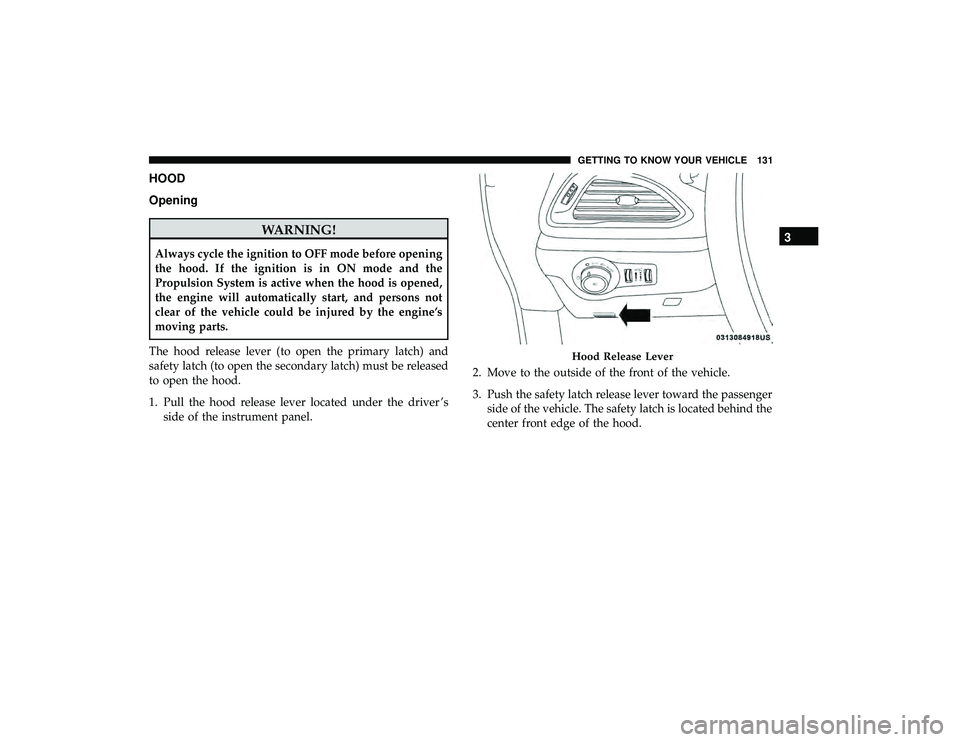
HOOD
Opening
WARNING!
Always cycle the ignition to OFF mode before opening
the hood. If the ignition is in ON mode and the
Propulsion System is active when the hood is opened,
the engine will automatically start, and persons not
clear of the vehicle could be injured by the engine’s
moving parts.
The hood release lever (to open the primary latch) and
safety latch (to open the secondary latch) must be released
to open the hood.
1. Pull the hood release lever located under the driver ’s side of the instrument panel. 2. Move to the outside of the front of the vehicle.
3. Push the safety latch release lever toward the passenger
side of the vehicle. The safety latch is located behind the
center front edge of the hood.
Hood Release Lever
3
GETTING TO KNOW YOUR VEHICLE 131
Page 135 of 620
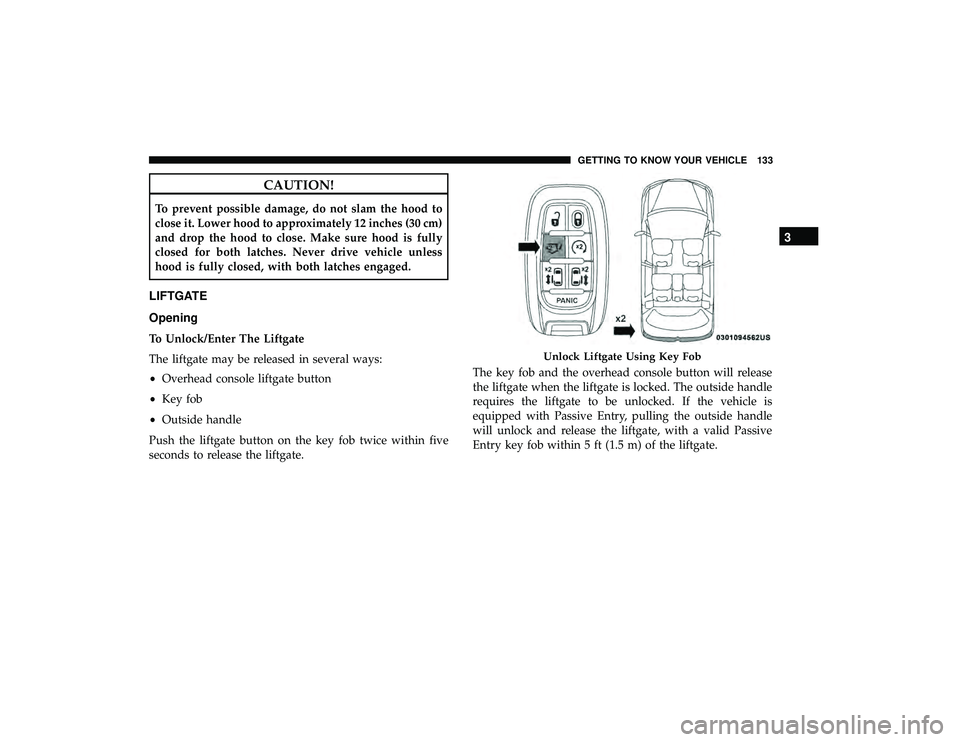
CAUTION!
To prevent possible damage, do not slam the hood to
close it. Lower hood to approximately 12 inches (30 cm)
and drop the hood to close. Make sure hood is fully
closed for both latches. Never drive vehicle unless
hood is fully closed, with both latches engaged.
LIFTGATE
Opening
To Unlock/Enter The Liftgate
The liftgate may be released in several ways:
•Overhead console liftgate button
• Key fob
• Outside handle
Push the liftgate button on the key fob twice within five
seconds to release the liftgate. The key fob and the overhead console button will release
the liftgate when the liftgate is locked. The outside handle
requires the liftgate to be unlocked. If the vehicle is
equipped with Passive Entry, pulling the outside handle
will unlock and release the liftgate, with a valid Passive
Entry key fob within 5 ft (1.5 m) of the liftgate.
Unlock Liftgate Using Key Fob
3
GETTING TO KNOW YOUR VEHICLE 133
Page 204 of 620
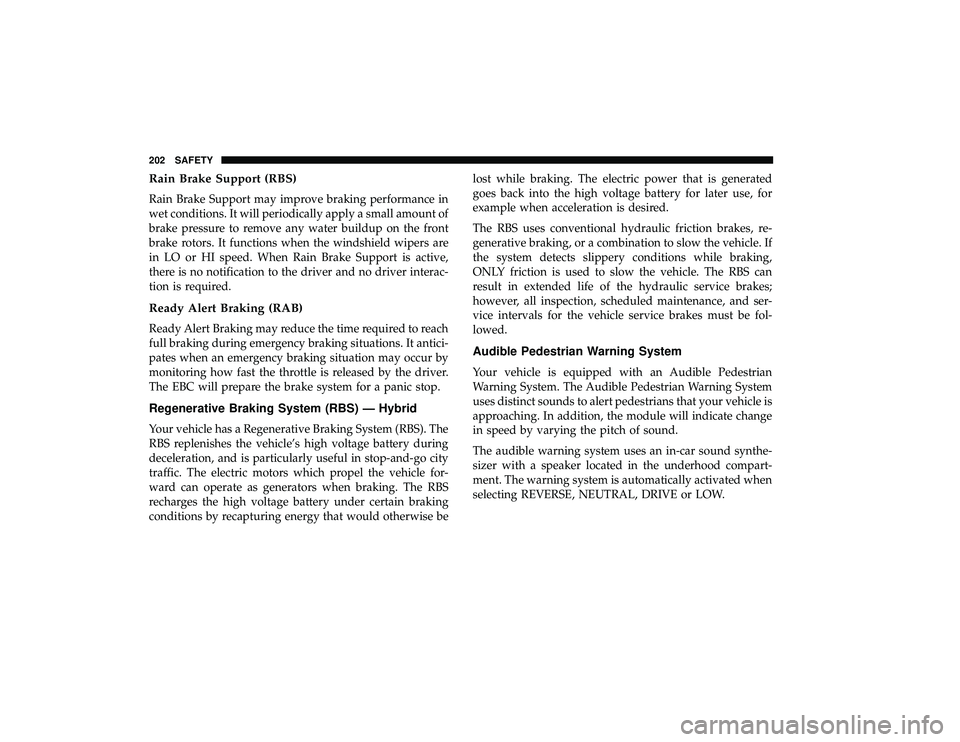
Rain Brake Support (RBS)
Rain Brake Support may improve braking performance in
wet conditions. It will periodically apply a small amount of
brake pressure to remove any water buildup on the front
brake rotors. It functions when the windshield wipers are
in LO or HI speed. When Rain Brake Support is active,
there is no notification to the driver and no driver interac-
tion is required.
Ready Alert Braking (RAB)
Ready Alert Braking may reduce the time required to reach
full braking during emergency braking situations. It antici-
pates when an emergency braking situation may occur by
monitoring how fast the throttle is released by the driver.
The EBC will prepare the brake system for a panic stop.
Regenerative Braking System (RBS) — Hybrid
Your vehicle has a Regenerative Braking System (RBS). The
RBS replenishes the vehicle’s high voltage battery during
deceleration, and is particularly useful in stop-and-go city
traffic. The electric motors which propel the vehicle for-
ward can operate as generators when braking. The RBS
recharges the high voltage battery under certain braking
conditions by recapturing energy that would otherwise belost while braking. The electric power that is generated
goes back into the high voltage battery for later use, for
example when acceleration is desired.
The RBS uses conventional hydraulic friction brakes, re-
generative braking, or a combination to slow the vehicle. If
the system detects slippery conditions while braking,
ONLY friction is used to slow the vehicle. The RBS can
result in extended life of the hydraulic service brakes;
however, all inspection, scheduled maintenance, and ser-
vice intervals for the vehicle service brakes must be fol-
lowed.
Audible Pedestrian Warning System
Your vehicle is equipped with an Audible Pedestrian
Warning System. The Audible Pedestrian Warning System
uses distinct sounds to alert pedestrians that your vehicle is
approaching. In addition, the module will indicate change
in speed by varying the pitch of sound.
The audible warning system uses an in-car sound synthe-
sizer with a speaker located in the underhood compart-
ment. The warning system is automatically activated when
selecting REVERSE, NEUTRAL, DRIVE or LOW.
202 SAFETY
Page 459 of 620
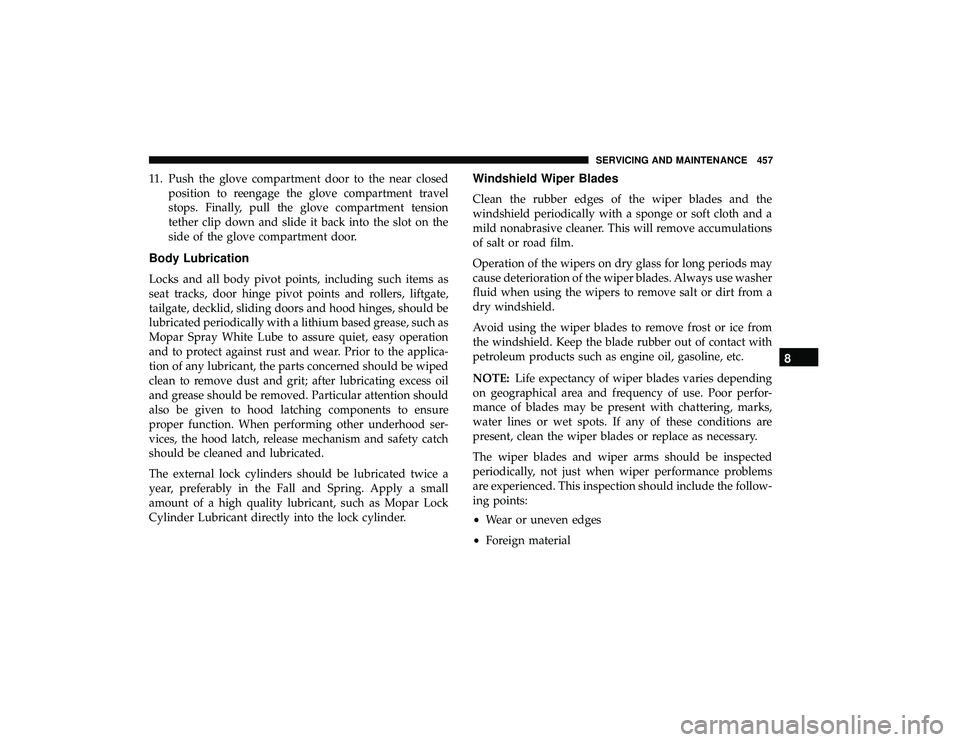
11. Push the glove compartment door to the near closedposition to reengage the glove compartment travel
stops. Finally, pull the glove compartment tension
tether clip down and slide it back into the slot on the
side of the glove compartment door.
Body Lubrication
Locks and all body pivot points, including such items as
seat tracks, door hinge pivot points and rollers, liftgate,
tailgate, decklid, sliding doors and hood hinges, should be
lubricated periodically with a lithium based grease, such as
Mopar Spray White Lube to assure quiet, easy operation
and to protect against rust and wear. Prior to the applica-
tion of any lubricant, the parts concerned should be wiped
clean to remove dust and grit; after lubricating excess oil
and grease should be removed. Particular attention should
also be given to hood latching components to ensure
proper function. When performing other underhood ser-
vices, the hood latch, release mechanism and safety catch
should be cleaned and lubricated.
The external lock cylinders should be lubricated twice a
year, preferably in the Fall and Spring. Apply a small
amount of a high quality lubricant, such as Mopar Lock
Cylinder Lubricant directly into the lock cylinder.
Windshield Wiper Blades
Clean the rubber edges of the wiper blades and the
windshield periodically with a sponge or soft cloth and a
mild nonabrasive cleaner. This will remove accumulations
of salt or road film.
Operation of the wipers on dry glass for long periods may
cause deterioration of the wiper blades. Always use washer
fluid when using the wipers to remove salt or dirt from a
dry windshield.
Avoid using the wiper blades to remove frost or ice from
the windshield. Keep the blade rubber out of contact with
petroleum products such as engine oil, gasoline, etc.
NOTE: Life expectancy of wiper blades varies depending
on geographical area and frequency of use. Poor perfor-
mance of blades may be present with chattering, marks,
water lines or wet spots. If any of these conditions are
present, clean the wiper blades or replace as necessary.
The wiper blades and wiper arms should be inspected
periodically, not just when wiper performance problems
are experienced. This inspection should include the follow-
ing points:
• Wear or uneven edges
• Foreign material
8
SERVICING AND MAINTENANCE 457
Page 609 of 620
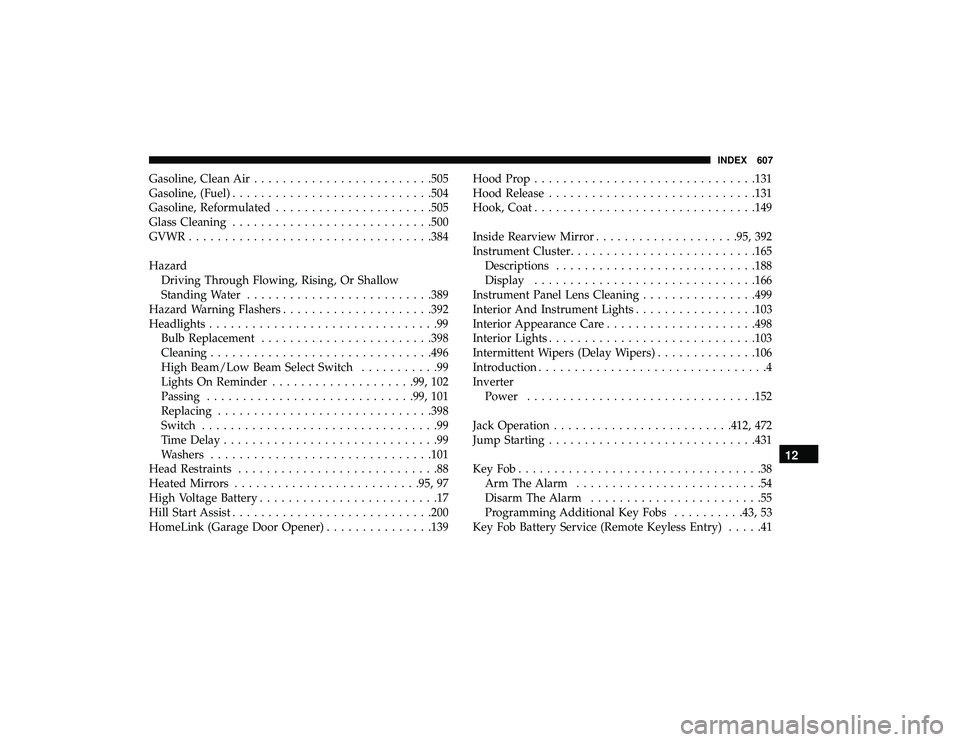
Gasoline, Clean Air........................ .505
Gasoline, (Fuel) ........................... .504
Gasoline, Reformulated ..................... .505
Glass Cleaning ........................... .500
GVWR ................................. .384
Hazard Driving Through Flowing, Rising, Or Shallow
Standing Water ......................... .389
Hazard Warning Flashers .................... .392
Headlights ................................99
Bulb Replacement ....................... .398
Cleaning .............................. .496
High Beam/Low Beam Select Switch ...........99
Lights On Reminder ................... .99, 102
Passing ............................ .99, 101
Replacing ............................. .398
Switch .................................99
Time Delay ..............................99
Washers .............................. .101
Head Restraints ............................88
Heated Mirrors ......................... .95, 97
High Voltage Battery .........................17
Hill Start Assist ........................... .200
HomeLink (Garage Door Opener) ...............139Hood Prop
.............................. .131
Hood Release ............................ .131
Hook, Coat .............................. .149
Inside Rearview Mirror ................... .95, 392
Instrument Cluster ......................... .165
Descriptions ........................... .188
Display .............................. .166
Instrument Panel Lens Cleaning ................499
Interior And Instrument Lights .................103
Interior Appearance Care .................... .498
Interior Lights ............................ .103
Intermittent Wipers (Delay Wipers) ..............106
Introduction ................................4
Inverter Power ............................... .152
Jack
Operation ........................ .412, 472
Jump Starting ............................ .431
KeyFob..................................38 Arm The Alarm ..........................54
Disarm The Alarm ........................55
Programming Additional Key Fobs ..........43, 53
Key Fob Battery Service (Remote Keyless Entry) .....41
12
INDEX 607
Page 613 of 620
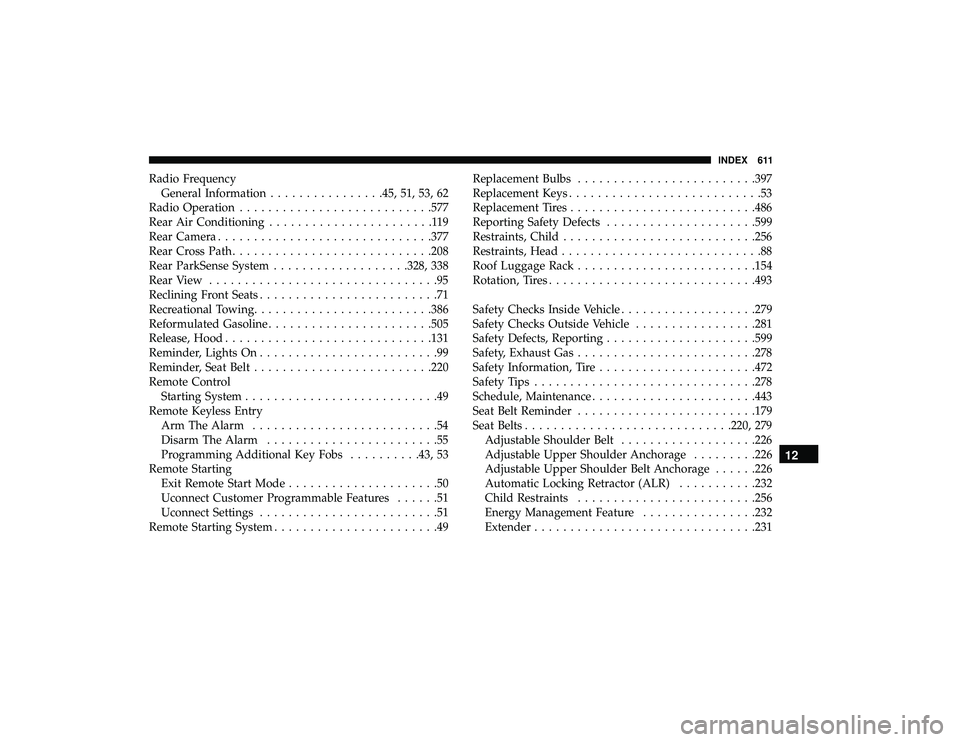
Radio FrequencyGeneral Information ................45, 51, 53, 62
Radio Operation .......................... .577
Rear Air Conditioning .......................119
Rear Camera ............................. .377
Rear Cross Path ........................... .208
Rear ParkSense System .................. .328, 338
Rear View ................................95
Reclining Front Seats .........................71
Recreational Towing ........................ .386
Reformulated Gasoline ...................... .505
Release, Hood ............................ .131
Reminder, Lights On .........................99
Reminder, Seat Belt ........................ .220
Remote Control Starting System ...........................49
Remote Keyless Entry Arm The Alarm ..........................54
Disarm The Alarm ........................55
Programming Additional Key Fobs ..........43, 53
Remote Starting Exit Remote Start Mode .....................50
Uconnect Customer Programmable Features ......51
Uconnect Settings .........................51
Remote Starting System .......................49 Replacement Bulbs
........................ .397
Replacement Keys ...........................53
Replacement Tires ......................... .486
Reporting Safety Defects .................... .599
Restraints, Child .......................... .256
Restraints, Head ............................88
Roof Luggage Rack ........................ .154
Rotation, Tires ............................ .493
Safety Checks Inside Vehicle ...................279
Safety Checks Outside Vehicle .................281
Safety Defects, Reporting .................... .599
Safety, Exhaust Gas ........................ .278
Safety Information, Tire ..................... .472
Safety Tips .............................. .278
Schedule, Maintenance ...................... .443
Seat Belt Reminder ........................ .179
Seat
Belts ............................ .220, 279
Adjustable Shoulder Belt ...................226
Adjustable Upper Shoulder Anchorage .........226
Adjustable Upper Shoulder Belt Anchorage ......226
Automatic Locking Retractor (ALR) ...........232
Child Restraints ........................ .256
Energy Management Feature ................232
Extender .............................. .231
12
INDEX 611